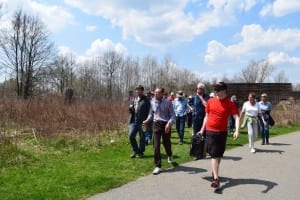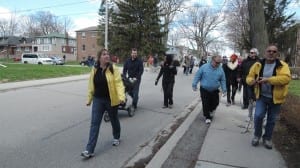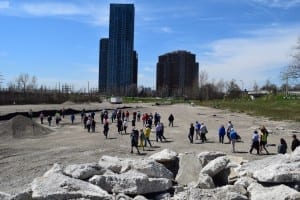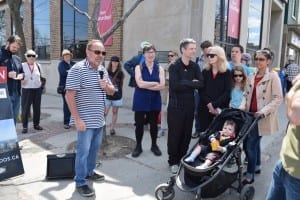2019 Festival Report for Jane’s Walk Toronto highlights communications, testimonials, and recommendations; however online version omits recommendations
Click here to access an abridged version of the Jane’s Walk Toronto 2019 Report >
I was interested to read what’s available of the above-mentioned report.
I note, however, that in the posted version, accessed on Sept. 4, 2019, pages 37 to 47 are missing.
Excerpt from report
An excerpt from the part of the report that is available online reads:
Community Outreach
Establishing Partnerships
A key part of the community outreach strategy was to establish partnerships and identify cross-promotional opportunities with like-minded organizations to increase visibility.
Some of the strategies included:
Contacting municipal government officials across the GTA to reach out to communities through their networks (newsletters, event listings, social media)
Reaching out to already organized and “ready to walk” groups such as ROMWalks, senior’s health programs and Meet-up groups
Partnering with existing events or initiatives such as the WalkTO Right to Walk panel in March and the GenWell Project overlapping with the Jane’s Walk Toronto festival weekend
Attending relevant events, networking and identifying opportunities to amplify the Jane’s Walk message through alternative platforms (e.g. podcasts)
The matter of partnerships, in any community endeavour, warrants careful thought as I will note below. But first, some comments about what a Jane’s Walk is.
Previous Jane’s Walks in Long Branch
I do not know what a Jane’s Walk is, as I’ve noted previously:

Walking south along Waterfront Trail during May 3, 2015 Jane’s Walk in Mississauga led by City of Mississauga Ward One Councillor Jim Tovey. A wooden baffle from the Long Branch Rifle Range, dating back from the 1890s, is visible in the background. Jaan Pill photo
One of the walks I co-led in May 2013 is featured at the Jane’s Walk Toronto site:
The text (which underlines the value of good planning, when organizing walks) reads:
The first Jane’s Walk in Long Branch, in 2012, attracted over 80 people. It took longer than we’d expected, and we were glad we’d brought along a portable sound system. The week before the walk, we learned details about a local park that we hadn’t known about before – especially about a road that used to extend along the shoreline of Lake Ontario, when the area was a thriving cottage community in the 1930s. The walkers were delighted to hear about this. “Wow, I never knew that!” was a typical response.
This year, our neighbourhood had two Jane’s Walks. We rehearsed and edited the routes for each event, to ensure they would not take more than 90 minutes. As before, we made a point of turning each walk into a conversation, not a top-down lecture. The walk leaders picked up as much new information as everybody else.
Again, we conducted advance research. We spoke with long-time residents who knew the area as children in the 1930s; some even provided us with photos and several hand-drawn maps, which we brought along to show the walkers. Though few of our interview subjects had the stamina to join us for a walk, they were delighted that they could share this valuable information. We also posted relevant images and details on my website about local history and events, PreservedStories.com.
The historic building shown in the photo is in New Toronto, a community just east of Long Branch. Now part of a skating facility at Colonel Samuel Smith Park, the building was formerly part of the Lakeshore Hospital Grounds, a psychiatric hospital which was closed down in 1979.
[End]
What happens at the periphery matters
Please note the above-noted excerpt says that the first Jane’s Walk in Long Branch took place in 2012. In fact there had been at least one Jane’s Walk some years earlier, as I’ve noted at my website. The 2012 walk was the first of the particular walks that were organized starting in that year, led by Jaan Pill and Mike James.
I note from the 2019 report, which speaks of the need to ensure there are walks outside of downtown Toronto, that South Etobicoke, where I organized many Jane’s Walks in years past, as I understand had a single walk in 2019, in the form of a bike tour.
I know the Long Branch event was well-organized as I was involved in discussions with David Juliusson during the planning of it:
Long Branch 135: A Jane’s Walk Bike Tour
It’s a great idea to get more involvement in Jane’s Walks, and in heritage preservation efforts as well, in areas outside the downtown core of Toronto. The southwest corner of Toronto on the Lake Ontario waterfront is such a peripheral area, which has a rich history like any other part of Toronto. I have highlighted the importance of considering the periphery at a previous post entitled:
Enthusiasm for local history is not enough, by itself, to preserve and repurpose heritage buildings
The value of the outlying neighbourhoods of Toronto, with regard to heritage and related matters, is also noted at a 2019 Heritage Toronto report:
Previous Jane’s Walks in South Etobicoke and Mississauga

Our May 4, 2014 Jane’s Walk began at Marie Curtis Park and proceeded through Long Branch (above) on the way to the Ontario Hospital Grounds in New Toronto. Jaan Pill photo
The photos at this post are from previous posts at this website about Jane’s Walk.
For several years I was involved first with co-leading (with my friend Mike James) of Jane’s Walks in South Etobicoke and later with organizing of such walks in Etobicoke and Mississauga.
I enjoyed reading the reference, in the recent Jane’s Walk 2019 report, regarding partnerships. The reference brings to mind a previous post, in which I refer to what the concept of community entails.
Community: A Contemporary Analysis of Policies, Programs, and Practices (2011)
As I’ve noted previously, the Stratford Public Library is smaller than the Toronto Public Library. Both library systems are impressive. The library in Stratford has fewer books than some libraries in Toronto but the ones on the shelves, in my anecdotal experience, are really well chosen.

Spaghetti Junction – The Farewell Tour. May 2, 2015 Jane’s Walk led by Etobicoke-Lakeshore MPP Peter Milczyn leaves Dundas Street West and moves toward the Six Points Interchange construction site. Jaan Pill photo
Among books I’ve learned about in Stratford, just by browsing shelves at the library, is a study entitled: Community: A Contemporary Analysis of Policies, Programs, and Priorities (2011).
I’m currently reading Community (2011) because it features a balanced, well-informed discussion (from the perspective of sociology and anthropology) of the intersection between neoliberalism and community.
The book features a multi-faceted, context-sensitive discussion about how community is defined. Sometimes, such definitions accord with evidence; at other times, they ignore the evidence on the ground.
There are many ways to define community. By way of example, the funding configuration for a given community-based project will influence how a community is defined; in some cases, such a term – that is, “community-based’ – may actually ignore the people living at a given geographical location. That is to say, the rhetoric associated with what a community-based project entails does not, at times, come anywhere close to matching the reality.
Partnerships and community engagement: Does the rhetoric match the reality?
In Chapter 4 in Community (2011), which focuses on partnerships and state funding, Katherine Kelly and Tullio Caputo ask whether the neoliberal state can set the agenda for things that need to get done (needs as expressed by a variety of interests) in the community, however the community may be defined.
The study notes that power and politics set up certain challenges, when the neoliberal state seeks to go about its business.

New Toronto – Then and Now, At May 2, 2015 Jane’s Walk, Mike James shares his recollections of his teenage years in New Toronto. The other walk leader, Brian Liberty, is visible at the left of the frame. Jaan Pill photo
The authors refer (p. 67) to case studies that “look at how the neoliberal state has tried to use its funding to control the local agenda in communities across the country by identifying with whom it will work and prioritizing the issues, programs, and services that it wants to fund.”
We can add that actually implementing the neoliberal agenda is a challenge:
“However, as we have seen in previous chapters,” the authors note (p. 67,) “the state’s power to control funding is no guarantee that its policies or programs will be either implemented as planned or supported by the community.”
As the study notes through a series of case studies, some partnerships involving community projects fail to meet their goals, for reasons that the authors specify. Some partnerships, on the other hand, are eminently successful, again for reasons that the authors specify.
Among other things, success involves inclusion of “individuals who are prepared to take action, not just plan for it” (p. 82) and it may involve ingenuity and creativity in addressing organizational challenges.
Success also involves building trust with regard, for example, to sharing of information among partners from different organizations.
Partnerships that work well are a source of inspiration for all concerned. The case studies in Community (2011) serve as tremendously valuable narratives, regarding challenges and opportunities of life in Canada in a neoliberal era. I am really pleased I came across this book.
Challenge of getting facts straight regarding local history
As I’ve noted at a previous post, it’s a challenge to get the facts straight when sharing information about local history, such as at meetings, online, in print, or on walks.
I strongly support efforts to get the facts straight regarding history, whether local history, national history, global history, or any other variation of it. To get the facts straight, it’s helpful to engage in standard practices of responsible journalism and historiography.
That is: Ensure that what you report has been verified and corroborated; don’t just repeat, without checking further, what someone else has said (whether online or in print). The story of a British colonel’s log cabin underlines what this means.
Getting the facts straight: Colonel Samuel Smith’s cabin was demolished in 1955 not 1952
After military service with the Queen’s Rangers in the American Revolutionary Wars, Colonel Samuel Smith was granted a large tract of land in 1793, which included all of what is now called Long Branch.
Originally a log cabin to which extensions and siding were added, the colonel’s house near Forty First Street and Lake Shore Blvd. West in Long Branch, was in continuous use for about 152 years, from 1797 until around 1949, before it was bulldozed in 1955.
Occasionally the date 1952 appears, especially online, and on captions on some archival photographs at Montgomery’s Inn, as the purported date of the latter demolition.
The available evidence, however, points definitively to 1955, as is evident from a Feb. 19, 1955 Toronto Star article, accessible at the Toronto Public Library website. From the latter article, it is clear that early in 1955, the Samuel Smith homestead house was still standing, awaiting its imminent demolition. Similarly, a Sept. 9, 1954 article in The Advertiser, about the same house, is entitled “Rare Historical Site Faces Demolition.”

Leave a Reply
Want to join the discussion?Feel free to contribute!